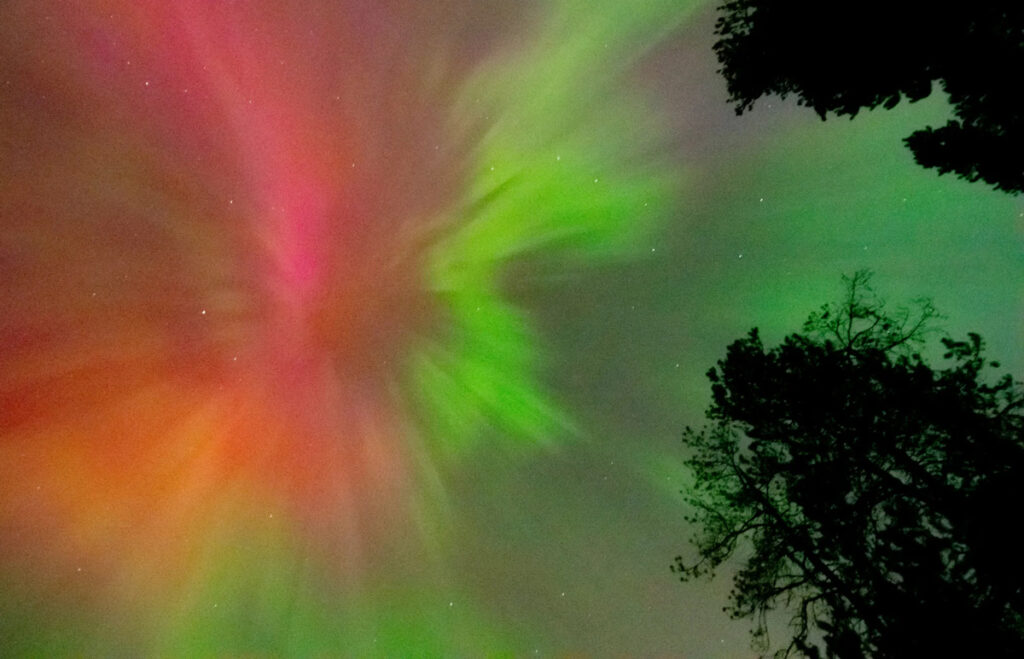In spring 2024, the night sky burst into a churning sea of colorful aurorae. As night crept across the globe, people from Florida to New Zealand marveled at the unusually widespread atmospheric light show for about 48 hours.
These serene aurorae arose from chaotic explosions on the Sun days earlier. In early May, an area of the Sun with a temporarily elevated magnetic field, known as an active region, spewed a stream of charged particles and radiation into the solar system before disappearing in late June. Some large solar events can disable electrical components on spacecraft and rain charged particles onto planetary bodies—which sometimes affects power grids and satellite communications on Earth.
In this case, the storms were mostly harmless, but something besides their intensity set them apart: The largest fleet of solar probes yet assembled was watching. Until recently, the only spacecraft closely observing the Sun were located on Earth’s side of the solar system, leaving scientists in the dark about active regions once they rotated out of sight from Earth. That changed when the European Space Agency launched its Solar Orbiter in 2020. In tandem with instruments aboard a constellation of other spacecraft, it has provided scientists with a way to view regions of the Sun throughout its 27-day rotation for the first time.
“It’s enabling us to do this type of research that was not available 5 or 6 years ago.”
“It’s enabling us to do this type of research that was not available 5 or 6 years ago,” said George Ho, a space physicist at the Southwest Research Institute.
In May, those eyes in space paid off. Stitching together observations from both sides of the Sun, scientists vigilantly tracked the active region, gaining new insights into how powerful particles fire off the Sun’s surface and wreak havoc within Earth’s magnetic field.
“Solar Orbiter is providing us with this new information, especially for these intense and very energetic events,” said David Lario, a research astrophysicist in the Heliophysics Science Division at NASA’s Goddard Space Flight Center. Lario and his colleagues presented their research on 11 December at AGU’s Annual Meeting 2024 in Washington, D.C.
Seeing the Sun in a New Light
Active regions can produce geysers of plasma known as coronal mass ejections (CMEs); explosions of radiation called solar flares; and shotgun blasts of high-speed particles, or radiation storms. A single active region can spit out any number of these hazards, which is what happened in May and June, when one hyperactive zone repeatedly fired off CMEs and flares.
“It was quite an intense and prolific active region,” Lario said.

CMEs, solar flares, and solar storms can affect our planet more strongly when they occur on the Earth side of the Sun, but their effects are not completely absent when they occur on the Sun’s farside. Hanging off the Sun are tentacles of magnetism called magnetic field lines. When these tentacles latch onto Earth’s own magnetic field, particles can spiral energetically along the field lines toward our planet’s poles. However, solar particles can also reach our planet through other paths that are less understood.
Lario and his team combined observations of this past spring’s active region from Solar Orbiter; Solar Terrestrial Relations Observatory (STEREO) A, which observes the Earth side of the Sun; and three near-Earth satellites or satellite networks: Geostationary Operational Environmental Satellites (GOES), the Solar and Heliospheric Observatory (SOHO), and the Solar Dynamics Observatory (SDO). This full suite of spacecraft exposed the active region’s churnings for two full rotations, including the eruption of a powerful solar flare on 20 May.
The Solar Orbiter allowed scientists to link the particles flooding out of the Sun’s farside with those being observed by spacecraft closer to our planet, similar to observing both the source of a flood and its downstream effects.
When this flare occurred, its source region was positioned so far from Earth that the Sun’s magnetic field lines likely wouldn’t have strongly bridged the region to our planet. Even so, the instruments detected charged particles near Earth. The researchers propose that instead of traveling along field lines, the energetic particles slowly pushed their way across the magnetic field lines heading toward Earth.
The Solar Orbiter allowed scientists to link the particles flooding out of the Sun’s farside with those being observed by spacecraft closer to our planet, similar to observing both the source of a flood and its downstream effects. This particle path gives scientists more to consider when imagining all the ways our star can affect—and even harm—Earth.
To date, Solar Orbiter has documented even stronger events than those observed in May and June, but they occurred at times when Earth was not in the Sun’s crosshairs.
“I guess we can say we dodged the biggest bullet,” said Ho, who was not involved in the research.
—Collin Blinder (@collinblinder), Science Writer


